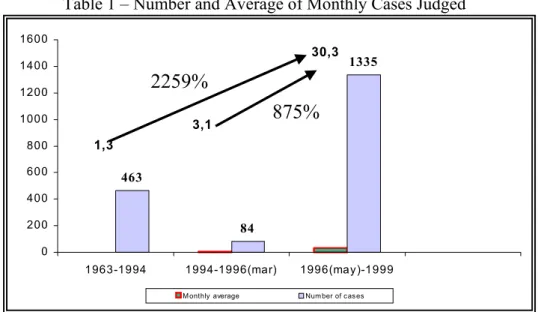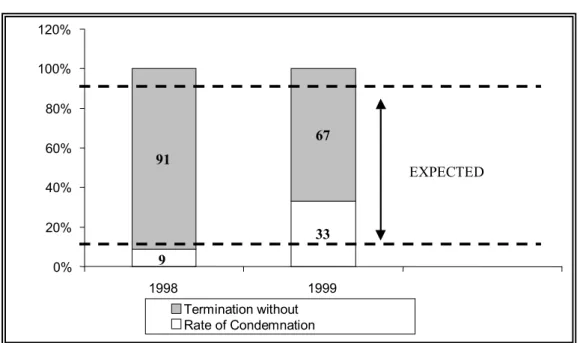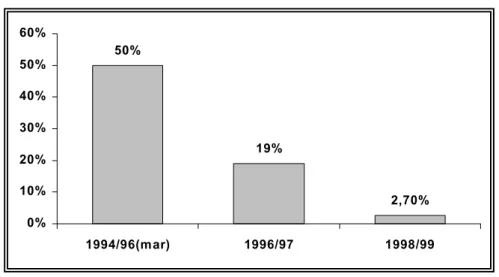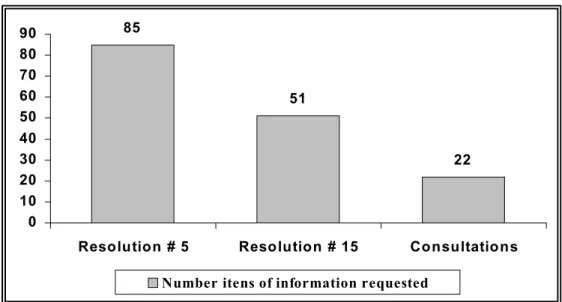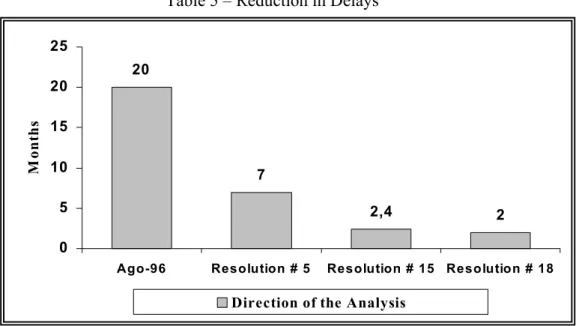Recent Trends and Prospects for Brazilian Antitrust
Gesner Oliveira
1Summary
1
Gesner Oliveira is president of CADE over the 1996-2000 term and is associate professor at EAESP/FGV. Paper prepared to the Third Annual Latin American Roundtable on Competition & Trade Policy, Coral Gables, FL, March 3, 2000.
1. The Development of Brazil's Antitrust Legislation and the Three Roles of CADE ... 2
1.1 The Development of Antitrust Legislation in Brazil...3
1.2 The Three Roles of CADE...3
2. Recent Trends in CADE's Performance ... 5
2.1 The Advances in CADE's Jurisprudence...5
2.2 Institutional Building...10
3. Future Prospects ... 10
Recent Trends and Prospects for Brazilian Antitrust
Antitrust policy has become increasingly important with the liberalization of the Brazilian economy over the 1990s. The role of the Administrative Council for Economic Defense (CADE) has come into center stage in the process.
As Table 1 demonstrates, the number of monthly cases judged increased 2259% with respect to the to the first three decades of CADE and has increased 875% with respect to the first two years after the enactment of the current antitrust law. 71% of the decisions of the 37-year CADE's history was taken in the period 1996-99.
Table 1 – Number and Average of Monthly Cases Judged
SOURCE: CADE.
The goal of this text is to review the main roles of CADE, describe the recent trends and discuss the prospects for the future. These points are developed in the next three sections, respectively.
1. The Development of Brazil's Antitrust Legislation and the Three Roles of CADE
The globalization of the economy induced the rapid dissemination of competition legislation around the world. Over eighty countries report having antitrust legislation today, in contrast with the less than forty countries until the 1980s.
Canada and Australia passed antitrust legislation contemporaneously to the
Sherman Act, but their implementation only gained importance during the 1980s. In Europe, national antitrust legislation was elaborated in the post-war years and the European Community normatives concerning antitrust policy were already included in articles 85 and 86 of the Treaty of Rome of 1957.
463
84
1335 30,3
3,1 1,3
0 200 400 600 800 1000 1200 1400 1600
1963-1994 1994-1996(mar) 1996(may)-1999
M onthly average Num ber of c as es
2259%
In the process of liberalization, privatization and deregulation, various developing countries, particularly in Latin America and Eastern Europe, have enacted antitrust legislation.
1.1 The Development of Antitrust Legislation in Brazil
In Brazil, although the first antitrust normatives are from the 1930s and the main
agency - Conselho Administrativo de Defesa Econômica – CADE - was created in 1962,
antitrust policy only gained relevance in the 1990s.
From the Constitution of 1937 until that of 1988, the prevailing tendency was to focus on "protection of the popular economy", typical of economies in which the government intervenes directly in the market. The Commission of Supply and Prices (SUNAB) was created in 1962 and the Inter-ministerial Price Council (CIP) was formed in 1968. These institutions promoted price fixing and coordination, generating distortions in the market.
In the late 1980s, the opening of the economy to international trade, deregulation and privatization brought Brazil closer to a true market economy, in which firm behavior is dependent on market forces and shaped by the rule of law. At the same time, the end of hyperinflation brought about by the 1994 "Real" Plan reestablished the notion of relative prices, re-focusing the public and private agents' to microeconomic factors.
A few weeks before the launching of the new currency, Law 8884 of June of 1994 was enacted reinforcing CADE's powers and transforming it into an independent agency, providing its President, six Commissioners and Attorney-General fixed mandates. In addition, the new legislation introduced merger control, enabled CADE to impose more austere penalties to antitrust illicit behavior, entrusted the Economic Law Office of the Ministry of Justice (SDE) the power to open investigation and entrusted the Office of Economic Monitoring of the Ministry of Finance (SEAE) the role of providing expert economic advice. All firms, including the public ones, are subject to Law 8884.
CIP and SUNAB were extinguished in 1991 and 1997, respectively. Industries providing basic infrastructure previously controlled by the government and subject to natural monopolies were privatized and subjected to regulation by agencies with more autonomy with respect to the central administration, such as the National Telecommunications Agency (ANATEL), the National Electric Energy Agency (ANEEL) and the National Petroleum Agency (ANP).
1.2 The Three Roles of CADE
CADE has three main roles: repressive, preventive and educational. The first one is to repress "infractions to the economic order" such as defined in articles 20 and 21 of Law 8884. Suppose, for example, that two or more firms in a particular relevant market establish a price agreement to function as a cartel. This constitutes an infraction according to articles 20 and 21, part II. An accusation may be made by any person or by the government itself.
If enough evidence of a possible infraction is presented to SDE, this secretary
will promote an administrative process. In case more evidence be needed a
preliminary inquiry will be will be made. Once the investigation is completed the process will be submitted to CADE for final ruling. If the Council considers the accusation correct, the penalties of Law 8884 apply. They are relatively less severe than those applied in the US, reaching 30% of the company's turnover or 15% in the case of a manager, directly or indirectly responsible for the infraction. Both penalties may be doubled in case of recidivation.
If a violation occurs in a regulated industry such as telecommunications, the investigation will be conducted by the sectoral agency, ANATEL. If the company involved infringes Law 8884, ANATEL will submit the process to CADE to impose the penalties.
Trade associations or professional associations may sometimes promote uniform commercial practices among its members. If such conduct is deemed illicit, the parties responsible for such practices will be subject to fines which may vary between US$ 3,500 and US$ 3,500,000.
Several other anticompetitive practices such as price discrimination and tying may in certain circumstances be deemed an infraction. Predatory pricing, defined as the artificial reduction of price below average variable cost with the intention of eliminating competitors and dominating the market, may also be an infringement. Since 1994, CADE has decided over 800 cases of anticompetitive conducts of various types.
The analysis of such practices requires a careful examination of the market effects of the different types of conducts. It is necessary to consider the specific context of each conduct occurred and its economic reasonableness. The costs and benefits must all be considered to determine the net effect on the market and on the consumer.
The Preventive Role: Merger Control
The second role of CADE is the prevention of infractions to the economic order through merger control. This is done according to article 54 of Law 8884, by the examination of contracts and operations such as mergers, acquisitions, joint-ventures and corporate reorganizations in which at least one of the participants detains a dominant position in the market.
Suppose, for example, that a foreign company with a revenue of R$ 400,000,0002 or holds 20% or more of the relevant market, acquires a national company or another foreign company operating in the country. The transaction should be presented to CADE within fifteen working days after the acquisition. CADE will approve or deny the transaction, taking into account among other factores, the technical studies provided by SEAE and SDE. Since Law 8884 went into effect, more than 400 operations of this type have been examined.
As in the United States, Canada and European Union, the majority of transactions submitted to CADE are approved (around 95%), with only a minority (5%) not being
approved or approved conditional to performance commitments.3
As in other countries, when a company or individual does not agree with a CADE’s decision, it is always possible to appeal to the courts.
The Educational Role
Last, but not least, CADE has an educational role. In addition to lectures, seminars
and pamphlets on the legislation, consultations to CADE are useful for this purpose.
Any citizen, public entity or company may consult the Council on issues relating to antitrust matters. This permits a useful debate over important topics such as the impact of state subsidies on competition or the need for regulatory reform on civil aviation. Effective implementation of antitrust legislation depends crucially on a cultural change in society, especially in Brazil, where protectionism and state intervention prevailed for so many decades.
2. Recent Trends in CADE's Performance
2.1 The Advances in CADE's Jurisprudence
One can identify recent advances in CADE's jurisprudence in the three roles described previously.
Conduct Control: The Repressive Role
CADE has demonstrated in 1999 that it is determined to combat anticompetitive practices. In this respect, one should highlight the condemnation of the price cartel in the
2
Four-hundred million reais is approximately 218.6 million dollars at the exchange rate of 7th of January of 2000.
3
steel industry which led to fines in the order of R$ 60 million.4 Previous decisions imposed sanctions on trade associations for the price setting schemes and uniform commercial practices.
In addition, CADE’s Resolution # 20 provided useful guidelines for dealing with anticompetitive practices. For the first time in Brazil technical criteria were explicitly considered by the authority in the evaluation of anticompetitive practices. This is an important task, given that some potentially illicit practices are not well known and are often mixed-up, such as in the case of predatory pricing and dumping.
These facts, together with the dissemination of the competitive culture led to a larger number of cases and an increase in the rate of condemnation of such practices in 1999, as shown on Table 2.
Table 2 - Rate of Condemnation in Conduct Cases 1998-1999
SOURCE: CADE.
It seems reasonable to suppose the existence of an expected interval in which, in principle, the condemnation rate should fall, indicated as being between 10% and 90% in Table 2. Such parameters serve only as a reference, since only with concrete jurisprudence over the next decades will more clear patterns be identifiable.
On the one hand, if an insignificant fraction of cases results in condemnation, one could consider that cases were examined erroneously or that the community was not aware about the law, leading to a large number of charges not applicable in terms of the legislation. This seems to have been the situation in the first years of Law 8884, to a great extent due to interventionist actions of the government which brought generalized
4
Administrative Process # 08000.015337/97-48, reported by Commissioner Ruy Santacruz. 33
91
67
9 0%
20% 40% 60% 80% 100% 120%
1998 1999
Termination without
d i
Rate of Condemnation
charges without properly defining the illicits involved and not respecting the due process. On the other hand, it would be naive to imagine that the rate of condemnation would reach 100%. One could suspect, in such a case, of a pro-accusation bias.
Last, but not least, with CADE’s Resolution # 19 the average delay was reduced from 191 days in 1998 to 24 among other factores in 1999, in the case of appeals to the Plenary of CADE under the presence of cease orders.
Merger Control: the Preventive Role
In relation to CADE's preventive role, the Council developed a non-interventionist posture, in line with the world trend, as observed by the reduction in CADE's intervention in merger control, in Table 3.
Table 3 – Intervention Rate in Merger Control
SOURCE: CADE.
In the first two years of application of Law 8884, performance commitments were imposed in a large proportion of cases in which article 54 of Law 8884 was applied, resulting in a large rate of intervention over the period of 1994-96, shown in Table 3 (50%). All approvals were conditioned to performance commitments during this period. A sharp contrast is observable starting in 1996 when the intervention rate fell, reaching 2.7% in 1998-99, which is in line with the international experience.
These numbers suggest two points. First, the control of article 54 does not exist to deter the merger wave. In fact, no agency in the world, no matter how active it has been, has been able to avoid major structural changes. The intention is only to block the small fraction of transactions which seem to effectively harm competition.
50%
19%
2,70% 0%
10% 20% 30% 40% 50% 60%
In fact, there continued to be an intense increase in mergers and acquisitions. At the end of the year more than 226 cases were examined, 7.6% above CADE’s forecast and 57% more than in 1998.
Second, since the majority of transactions does not warrant intervention, the initial examination of all cases should be very simple, in order to avoid imposing high transaction costs on the economy, hampering the competitive market which CADE intends to foster.
This shows the importance of the simplification of the analysis initiated by Resolution #5 of 1996 and improved by Resolution #15 of 1998. This is reflected in the decrease in the number of documents and information requested, shown in Table 4 and resulted in a decrease in delays, according to Table 5.
Table 4 – Reducing Bureaucracy
SOURCE: CADE
85
51
22
0 10 20 30 40 50 60 70 80 90
Resolution # 5 Resolution # 15 Consultations
Table 5 – Reduction in Delays
SOURCE: CADE
This trend of reducing the bureaucracy is well illustrated by CADE's decision to be more flexible with respect to the requirement of translations and particularly of official
translation of foreign documents.5
Last but not least, the jurisprudence of CADE introduced an innovation in July of 1999 with the adoption of a precautionary measure in the case of the Antarctica and Brahma merger as well as in January of 2000 in the case of the acquisition of Sprint by MCI.
CADE has also become more rigorous with regard to late notification. Gradually, the definition of the moment of occurrence of the transaction according to article 54 of Law 8884 was more precisely defined. In 1999, the late notification rate was 19%, compared with 7% in 1988.
Promotion of Free Competition: The Educational Role
As emphasized earlier, it is impossible to overstate the importance of the dissemination of competition culture in countries like Brazil.
Capacity building is a first target. In 1999, CADE together with the Ministry of Education and the Education Commission of the House of Representatives recommended the introduction of antitrust studies in the undergraduate and graduate curricula of Law, Economics, Business, Engineering and other related majors.
5 See the legal opinion of the Attorney General of CADE, Amauri Seralvo and the vote of Commissioner Mércio Felsky in Concentration Act # 08012.004759/99-84.
20
7
2,4 2
0 5 10 15 20 25
Ago-96 Resolution # 5 Resolution # 15 Resolution # 18
M
o
nt
hs
In the same direction, seminars and workshops were held in several capitals of the country. CADE's Internship Program enabled more than 200 students from 13 different cities to work at CADE.
Second, the passing of Resolution 18 in the end of 1998 sought to provide orientation through consultations. This permitted CADE to contribute to the debate of questions of national importance, such as the "fiscal war" among the states of the federation, as well as themes related with the day-to-day routine of consumers such as the
issue stores hours on Sundays.6 The average time of analysis of consultation was reduced
from 447 days in the period 1994-98 to 60 days after the passing of Resolution 18.
Lastly, CADE innovated by decentralizing its activities. Several events, including public hearings about major cases, were held in different cities of the country.
2.2 Institutional Building
The advances in CADE’s jurisprudence were accompanied by a systematic effort to strengthen the agency. Four recent changes should be pointed out.
First, in the beginning of the year Temporary Measure (Medida Provisória)#1793
of 1998, later approved by Congress in Law 9781 of the 19th of January of 1999, cretaed a notificatin fee. These charges provided R$ 5 million in 1999, which was applied towards the modernization of CADE. Though insufficient to supply the needs of the agency, CADE's budget increased from R$ 2.9 million in 1998 to R$ 9.8 million in 1999.
Second, in line with the commitment made on occasion of CADE's 37th anniversary on September 10, CADE began its efforts of moving to new facilities. In addition to providing for more adequate facilities for the realization of its functions, such change symbolizes the independence of the competition authority.
Third, CADE received its third Hélio Beltrão Prize for the introduction of new methods of administration.
Lastly, the strategy of establishing partnerships with a particular emphasis on regulatory agencies led to an increase in the number of partnerships from 30 to 57 in 1999.
3. Future Prospects
The recent experience of CADE stands out among the antitrust jurisprudence of the developing countries. However, certain structural difficulties associated to institutional under investment and the lack of competition culture persist.
The continued efforts aimed at strengthening competition will require further development in three areas:
i) overcome the institutional under investment with the creation of a
permanent workforce at CADE, already determined by article 81 of Law 8884, but not yet implemented;
ii) achieve greater interaction between CADE and the regulatory agencies;
iii) rationalize the division of work among the Brazilian competition bodies
and reduce the bureaucracy associated with conduct and merger controls.
